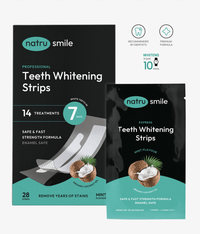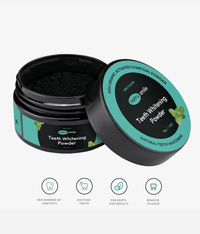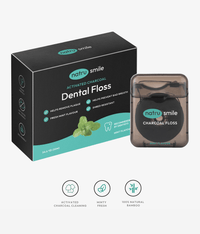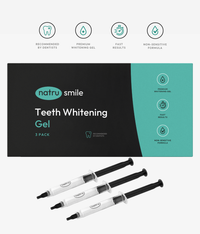
All products are certified by dental expert Dr. Greg Grillo
With so many brands, flavors, and varieties available on store shelves today, it’s hard to know which toothpaste is best for you and your family. The global toothpaste market is expected to be worth $21.99 billion by 2027 due to the increase in poor eating habits and demand for oral care products to tackle dental health issues. From fluoride-free vegan options to whitening formulas, new products seem to come out every few months.
And you might be thinking, how different can they really be? The answer is a lot!
Selecting the wrong toothpaste could mean missing out on key benefits such as preventing cavities or whitening teeth.
To help improve your smile and make your decision easier, our comprehensive guide will show you how to choose the right toothpaste.
Weighing Your Toothpaste Options (Overview)
You're approaching the toothpaste aisle, and it's time to make a decision. Before you start reading labels and determining which is the better toothpaste, there are some important factors to consider:
- Brand: One of the most important things to consider when choosing a toothpaste is the brand. Different companies use different formulas, so make sure to do your due diligence and research what ingredients each brand uses and how effective they are. For instance, Arm & Hammer toothpastes are known for their use of baking soda, while Colgate toothpastes are known for their anti-microbial properties.
- Flavor: Toothpaste comes in a variety of flavors, ranging from minty fresh to bubble gum and even chocolate! Choose one that you enjoy since this will make brushing your teeth more enjoyable.
- Ingredients: Pay close attention to the list of ingredients on the back of the tube or box. Some ingredients can be beneficial, while others can be harmful to your health, so you’ll want to know exactly what you’re putting in your mouth. We’ll get more into this in the next section of the guide.
- Price: Another factor that should be taken into consideration is price. There are kinds of toothpaste available for every budget, but the most expensive ones aren’t necessarily the best ones for you and your family.
- Reviews: Finally, read reviews from other customers who have used the product. This will give you a better idea of the toothpaste’s performance and whether or not it is worth the price.
- Form: Toothpaste comes in a variety of forms, including gel, paste, and powder. Paste toothpastes are the standard, while gel toothpastes are usually easier to spread on the brush. When it comes to tooth powder vs. toothpaste, powder toothpastes are becoming increasingly popular because they don’t contain any harsh chemicals. There are even toothpaste tabs, which are a great choice for those who don’t like the mess of traditional toothpaste.
Other Things To Consider When Choosing A Toothpaste
If you have a general idea of what you’re looking for, it’s time to check out what’s in the tube:
- Fluoride: Fluoride is the most essential component in any toothpaste because it helps prevent cavities. There are many things fluoride is responsible for relating to oral health, including strengthening the enamel, reducing the amount of acid bacteria produce, and removing plaque. Look for a formula that contains between 1000-1500 parts per million (ppm). An alternative is hydroxyapatite toothpaste, which helps protect teeth from acid erosion and cavities.
- Whitening Agents: Does whitening toothpaste work? If you’re looking to brighten your smile, choose toothpaste with whitening agents such as hydrogen peroxide or baking soda. These ingredients will gently remove surface stains and make your teeth look whiter and brighter over time.
- Tartar Control: For those who are prone to tartar buildup, choose a toothpaste with anti-tartar ingredients such as pyrophosphates or zinc citrate. These agents help slow down the formation of hard deposits on your teeth and prevent decay.
- Natural Ingredients: Some unique toothpaste options boast natural ingredients, and there are plenty of fluoride-free toothpaste options that use only organic and vegan ingredients, such as coconut oil, tea tree oil, and aloe vera. Formulas like this are free from harsh chemicals and artificial flavors, so they’re a great option for those who want to reduce their exposure to toxins.
Types Of Toothpaste
Now that you have a better understanding of what to look for when choosing a toothpaste, let’s take a look at the different types of toothpaste available.
Children’s Toothpaste
Children’s toothpaste is specially formulated for kids and comes in a variety of flavors to make brushing more enjoyable. Typically, this kind of toothpaste contains less fluoride than adult formulas since too much can cause fluorosis (white spots on the teeth). Adult formulas can also be too abrasive and have too much flavor in them. Since some of the adult population drink coffee and tea, smoke, and eat certain foods, toothpaste has to address these factors.
Research shows that the ideal children’s toothpaste should have the appropriate abrasitivity and maximize fluoride availability and be pleasant flavor-wise in order to get children to take care of their teeth.
Toothpaste Rich In Fluoride
Fluoride is an important ingredient in toothpaste as it helps to prevent cavities and strengthen enamel. While most kinds of toothpaste contain fluoride, some contain higher concentrations than others. If you’re looking for extra cavity protection, opt for one with a high amount of fluoride.
To give you an idea of how much fluoride is considered high, most American toothpastes have around 1,000 to 1,100mg/L of fluoride.
Tartar Control
If you struggle with plaque or tartar, tartar control toothpaste can help to prevent further buildup. This type of toothpaste contains an active ingredient, such as pyrophosphates, that helps to reduce tartar buildup on teeth. Pyrophosphate is an anti-calculus agent, which means it slows down the hardening process of plaque, so you have more time to remove it with regular brushing.
Toothpaste For Sensitive Teeth
Sensitive teeth can be caused by receding gums, worn tooth enamel, or even tooth decay. If you’re dealing with sensitive teeth, look for a toothpaste specifically made for sensitive teeth like Sensodyne. These formulas contain ingredients that help to reduce sensitivity while providing the same cleaning and whitening benefits of regular toothpaste.
Anti-sensitivity ingredients such as potassium nitrate and stannous fluoride are what help soothe the nerves in your teeth and create a barrier over sensitive spots.
Whitening Toothpaste
Whitening toothpastes are formulated to help remove surface stains on teeth caused by drinking coffee, tea, or red wine. This type of toothpaste contains abrasive particles that gently polish away the stains while brushing. Think of it as an at-home teeth whitening method.
However, it’s important to note that they won’t change the color of your teeth dramatically (only professional teeth whitening options can do that). This is because these kinds of toothpaste can only work on removing surface stains.
Herbal Toothpaste
There are many herbal toothpastes available for those looking for an all-natural solution. These formulas contain natural ingredients such as aloe vera, chamomile, and tea tree oil that help to reduce bacteria and keep your breath fresh. Some of these kinds of toothpaste don't contain fluoride, so be sure to check the label carefully if you still want to protect against cavities.
Where To Look Before Buying A New Toothpaste
There are certain things you can check out before truly making a final decision, and these might include:
Opt For ADA Approval
The American Dental Association (ADA) is the most well-respected dental organization in the United States, and it has a "Seal of Acceptance" for products that meet its standards. Whenever possible, try to select toothpaste with ADA approval.
Other countries will have other national dental associations, so be sure to look for approval from your own country.
Ensure The Toothpaste Contains Fluoride
Most toothpaste brands will have fluoride in them, but it’s important to double-check. Fluoride is essential for preventing cavities and remineralizing teeth, so make sure your choice contains this ingredient.
Some natural kinds of toothpaste may not have fluoride, as they claim to contain only natural ingredients. In this case, you can consider adding other oral hygiene products to your routine, such as mouthwashes with fluoride.
Pay Attention To Ingredients
Always check the ingredients list on any toothpaste you’re considering buying.
Look for key ingredients like fluoride and other active ingredients like pyrophosphates, enzymes, or baking soda.
Especially if you have specific dental needs, such as whitening or sensitivity, you may want to look for additional ingredients that can help with those issues.
Similarly, people may also want to avoid certain ingredients like artificial sweeteners and preservatives.
Flavor And Texture
Flavor and texture are two other important factors to consider when choosing toothpaste. Some people prefer strong mint flavors, while others might want something more subtle, like bubblegum or fruit. The texture is also important, as some people may find thicker pastes easier to handle than thinner ones.
Although this might seem like a trivial part of choosing an effective toothpaste, finding one you actually like will encourage you to use it more often.
Want to dive a little deeper and learn more about the world of toothpaste? Read on.
What Toothpaste Do Dentists Recommend?
Most dentists recommend toothpaste with fluoride, as this helps to prevent cavities and remineralize teeth. It’s also important to look for the ADA seal of approval on any product you buy. Joseph Field (DDS) outlines a few things a good toothpaste should do, including remineralizing the surface of the teeth, restoring minerals, eliminating plaque and bacteria, helping offset erosion and staining, and preventing cavities, tooth decay, and gingivitis.
What Is The Best Way To Apply Toothpaste?
To get the most out of your toothpaste, make sure you brush for at least two minutes twice a day. Make sure to focus on each individual tooth and use gentle circular motions with your brush. As well, look for ways to brush your teeth correctly to improve your technique. The amount of toothpaste you use will depend on your age and the type of brush you have. For adults, it’s recommended to use a pea-sized amount, while children should only use a smear or dab.
How Long Should I Leave Toothpaste In My Teeth?
Most dentists recommend that you leave the toothpaste in your mouth for at least two minutes before rinsing, hence why you should brush for a minimum of two minutes. This will give it enough time to work its magic and help protect against cavities.
Is It Better To Wet Your Toothpaste Before Brushing?
There is currently no concrete evidence to suggest that wetting or not wetting your toothpaste before brushing changes the status of your oral health.
However, Dr. Raha Sepehrara advises against drenching your toothbrush in water as it will dilute the toothpaste.
Can You Leave Toothpaste On Your Teeth Overnight?
No, you should not leave toothpaste on your teeth overnight. It’s best to brush with toothpaste for two minutes and then rinse thoroughly. This is because leaving the fluoride too long on your teeth can cause fluorosis, which is a discoloration of the enamel.










